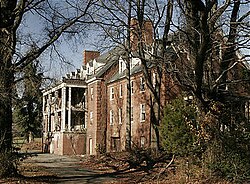Glenn Dale Hospital
|
Glenn Dale Tuberculosis Hospital and Sanatorium
|
|

The Glenn Dale Hospital
|
|
| Location | 5201 Glenn Dale Rd., Glenn Dale, Maryland |
|---|---|
| Coordinates | 38°57′39″N 76°48′48″W / 38.96083°N 76.81333°WCoordinates: 38°57′39″N 76°48′48″W / 38.96083°N 76.81333°W |
| Area | 206.11 acres (83.41 ha) |
| Built | 1934 |
| Architectural style | Colonial Revival |
| NRHP Reference # | 11000822 |
| Added to NRHP | November 18, 2011 |
Glenn Dale Hospital was a tuberculosis sanatorium and isolation hospital in Glenn Dale, Maryland, in the United States. It is a large facility, consisting of 23 buildings on 216 acres (87 ha), that was built in 1934 and closed in 1981 due to asbestos.
Though it is now closed and may be eventually demolished, for decades it was an important public health institution near Washington, DC. The Maryland-National Capital Park and Planning Commission Park Police patrol the hospital grounds regularly.
The hospital grounds consist of several buildings:
Other parts of the hospital include: art rooms, staff housing, nurses' homes, playgrounds, theater, seclusion rooms, storage areas, chapels, morgues, and boiler rooms.
The buildings are characterized by broken glass, peeling paint, corroded walls and overgrown vines. Several of the buildings also have collapsed roofs.
The children's hospital building and adult hospital building are the most widely explored structures by local trespassers. This is primarily due to their close distance to Glenn Dale Road, a local street that bisects the hospital grounds.
Contrary to popular belief, the large incinerator present on the hospital grounds was not used for the destruction of human remains. Instead, hospital waste was burned.
Both the children's and adults' buildings are connected by a series of underground tunnels, like many sanitariums. These walkways join the basements of both buildings together. The basements of the hospital buildings are extremely dangerous and filthy. Large pieces of rusty, sharp metal, cloth and debris hang from the ceiling, and the buildings contain large amounts of asbestos and lead paint. Each hospital basement has its own morgue. Today, these walkways are littered with garbage, broken glass, and graffiti. The hospital basements are also infested with rats and bats. In addition, parts of the walkways are flooded with nearly 3 feet (0.91 m) of water.
...
Wikipedia


